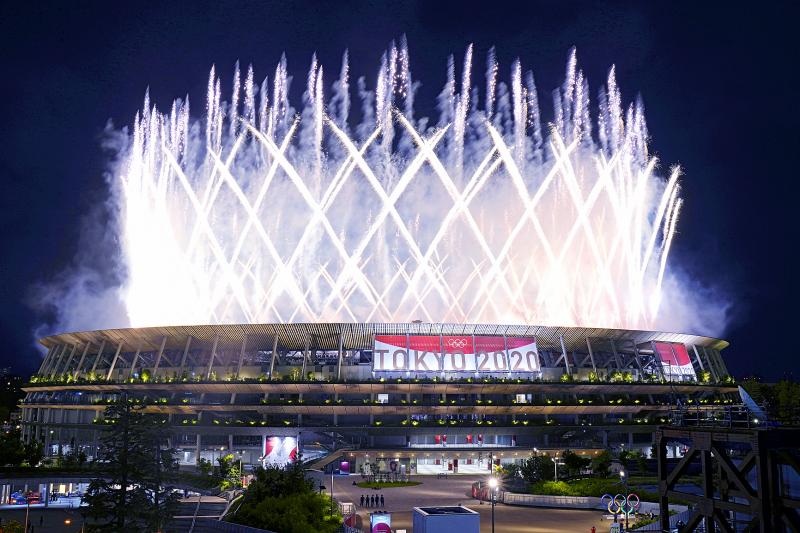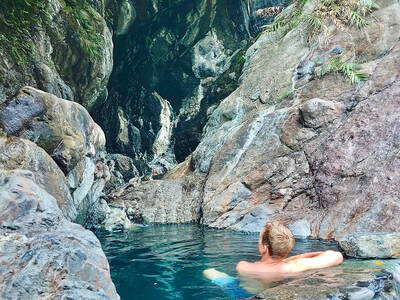The Yoyogi National Stadium by Kenzo Tange was the elegant symbol of Tokyo’s 1964 Summer Olympics, a combination of modern technique and Japanese tradition.
Tange was awarded the Pritzker prize in 1987 — architecture’s highest award — and the citation described Yoyogi as “among the most beautiful buildings of the 20th century.”
It remains so. Simple. Striking. Timeless.

Photo: AP
It went up just 19 years after Japan’s defeat in World War II, a time when building materials were in short supply in the country. It offered an early glance into a modernizing Japan that included tiny transistor radios, bullet trains, and ubiquitous labels that read “Made in Japan.”
Yoyogi’s sweeping roof is anchored to earth and held up by steel cables — like a suspension bridge — and connects modern, western design with forms found in Japanese temples and shrines.
“It’s kind of a miracle,” said professor Souhei Imamura, who teaches architecture at the Chiba Institute of Technology. “It combines structure, form and also function. Each is unique and they are blended. Dynamism was required at the time because Japanese society wanted to change, to evolve. The dynamism was also needed for those Olympics.”
Yoyogi endures like a 500-year-old European cathedral and sits next door to the sprawling park and Meiji Shrine in central Tokyo. Small by today’s standards, Yoyogi was the swimming venue in ‘64 where American teenager Don Schollander won four gold medals. He was the Mark Spitz or Michael Phelps of Tokyo 57 years ago.
This time it’s the venue for team handball, and was also used for a gymnastic event last year when organizers began testing anti-COVID-19 measures they might use in order to hold the Olympics during a pandemic.
Tange also designed a companion building next door — usually called the Annex — that was the basketball venue in ‘64 where the Americans won gold with players like Bill Bradley, Jeff Mullins and Jerry Shipp.
“Like the Meiji Shrine, most of the traditional buildings in Japan have a big roof. The symbol is the roof. It’s quite different from western building where the emphasis is mainly on the facade,” Imamura explained.
Besides Yoyogi, the Nippon Budokan is the other well-known venue being used from ‘64, again for judo. Budokan literally translates in English as “martial arts hall.”
A series of Beatles’ concerts in 1966 gave the Budokan its world fame, probably more so than the ‘64 Olympics.
American architect James Lambiasi, who has worked for 26 years in Japan, has described Yoyogi as the “pinnacle of modern architecture.” He pointed out that Tokyo was a wooden city recovering after the war and, the concrete and steel contributed to the city’s rebirth.
“When you describe a building as iconic, or really representing its time, it’s not just one thing about it, it’s like this perfect storm of different conditions coming together that make it really special,” explained Lambiasi, who practices architecture it Tokyo at teaches at Temple University in Tokyo.
“It’s the way in which Tange was able to have something completely modern and yet somehow reflecting the cultural design and the spirit of Japan.” Lambiasi added. “That’s where it became this iconic building and checked all of the boxes.”
He likened Tange to Catalan architect Antoni Gaudí whose organic, modernist buildings from the late 19th and early 20th century populate Barcelona with buildings like the church of Sagrada Familia and Casa Mila.
“It’s not the same thing, but the spirit of it is very, very similar,” Lambiasi said. “Gaudi was the genius who didn’t follow any rules. He came up with new, incredible things that came out of nowhere.”
Lambiasi also pointed out the era in which Tange worked. This was before computer graphics or computer modeling, when architects and engineers worked on a drafting table with a T-square and slide rule. Tange added imagination to those basic tools.
“I just cannot imagine doing that building without a computer,” Lambiasi said. “And the fact they were able to calculate all the movement going on; everything being calculated out by hand, basically.”
Despite the engineering complexity, the Yoyogi’s design is basic. Lambiasi joked that many engineers working with Tange “earned PhDs” trying to turn his designs into reality.
“Yoyogi is like a tent where you have two poles and the cable goes from the ground to the top of the pole — and then between the poles — and back to the ground,” Lambiasi explained. “Being anchored to the ground keeps everything up. The concept is very primitive, very simple. It’s beautiful in its simplicity.”

As I finally slid into the warm embrace of the hot, clifftop pool, it was a serene moment of reflection. The sound of the river reflected off the cave walls, the white of our camping lights reflected off the dark, shimmering surface of the water, and I reflected on how fortunate I was to be here. After all, the beautiful walk through narrow canyons that had brought us here had been inaccessible for five years — and will be again soon. The day had started at the Huisun Forest Area (惠蓀林場), at the end of Nantou County Route 80, north and east

Specialty sandwiches loaded with the contents of an entire charcuterie board, overflowing with sauces, creams and all manner of creative add-ons, is perhaps one of the biggest global food trends of this year. From London to New York, lines form down the block for mortadella, burrata, pistachio and more stuffed between slices of fresh sourdough, rye or focaccia. To try the trend in Taipei, Munchies Mafia is for sure the spot — could this be the best sandwich in town? Carlos from Spain and Sergio from Mexico opened this spot just seven months ago. The two met working in the

Exceptions to the rule are sometimes revealing. For a brief few years, there was an emerging ideological split between the Democratic Progressive Party (DPP) and Chinese Nationalist Party (KMT) that appeared to be pushing the DPP in a direction that would be considered more liberal, and the KMT more conservative. In the previous column, “The KMT-DPP’s bureaucrat-led developmental state” (Dec. 11, page 12), we examined how Taiwan’s democratic system developed, and how both the two main parties largely accepted a similar consensus on how Taiwan should be run domestically and did not split along the left-right lines more familiar in

This month the government ordered a one-year block of Xiaohongshu (小紅書) or Rednote, a Chinese social media platform with more than 3 million users in Taiwan. The government pointed to widespread fraud activity on the platform, along with cybersecurity failures. Officials said that they had reached out to the company and asked it to change. However, they received no response. The pro-China parties, the Chinese Nationalist Party (KMT) and Taiwan People’s Party (TPP), immediately swung into action, denouncing the ban as an attack on free speech. This “free speech” claim was then echoed by the People’s Republic of China (PRC),